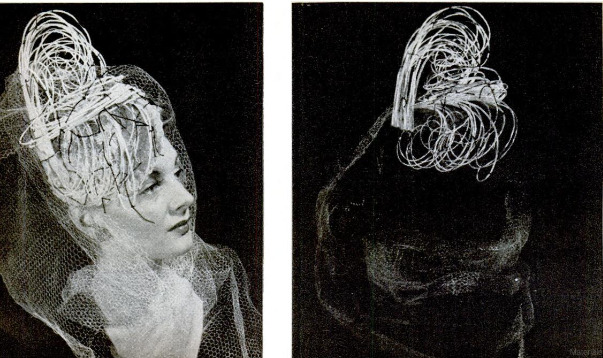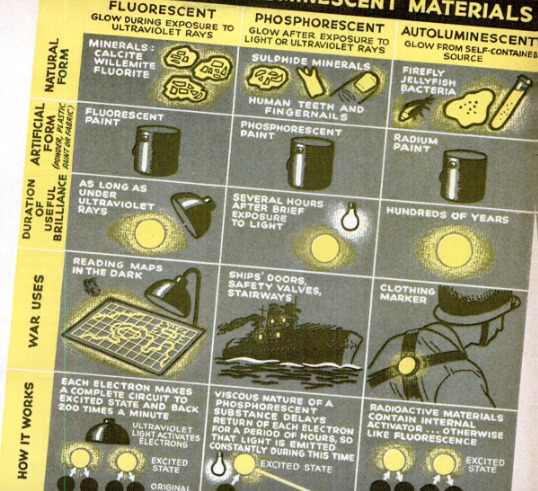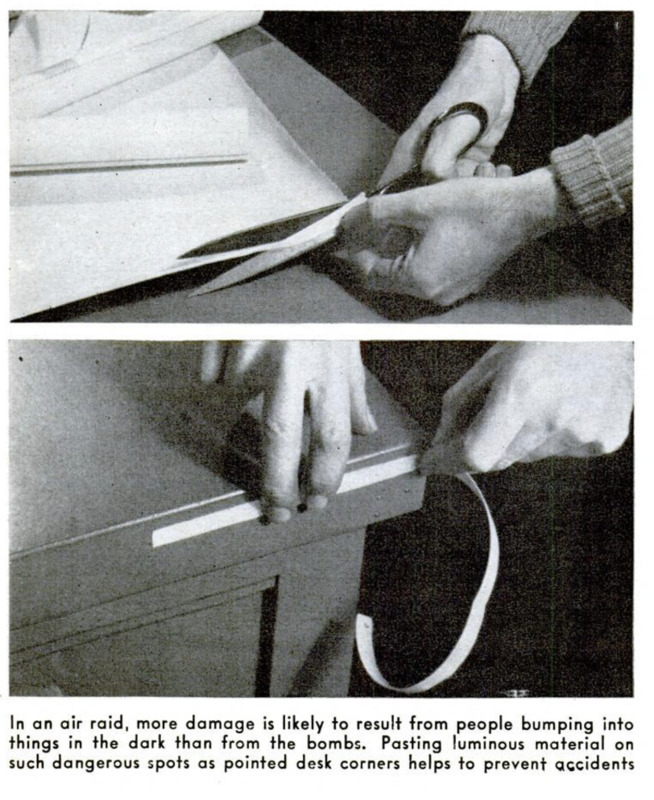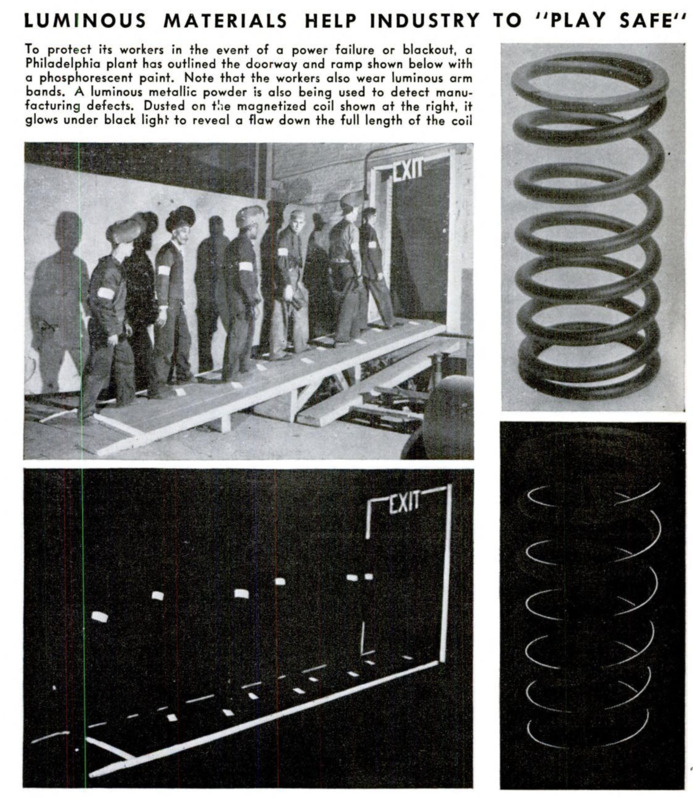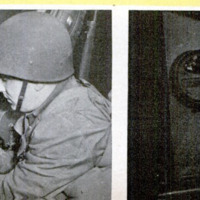-
Titolo
-
Fighting on a thousand fronts is "Ghost Light" our new weapon in the dark
-
Article Title and/or Image Caption
-
Fighting on a thousand fronts is "Ghost Light" our new weapon in the dark
-
extracted text
-
A LEADER of a night scouting party |
consults his map. As he is near the
enemy lines, it would be suicide to strike
a match or use a flashlight. No need.
Printed in luminous ink, lines of the map |
shine dimly but clearly in the dark. |
The party moves on. Lest his men be-
come separated from him, the leader wears |
a faintly glowing button on his back. |
Similarly, to the rear, ghostly processions |
of blacked-out tanks and troop-loaded trucks |
are advancing in follow-the-leader style,
each guided by a spot of luminous paint
on the one ahead. |
Now the scouts have completed their
mission. To mark directions for the secret
troop movement, they have daubed roads
and trees with splotches of ordinary-looking
paint. When a soldier turns the invisible
beam of a special black-light flashlamp upon |
one of the painted direction markers, it lights |
up as plainly as a traffic signal. |
Through 30 centuries, from the time when
ancient Egyptians used light-emitting min-
erals to create a mysterious glow around
tempie altars, the phenomenon called lumi-
nescence remained no more than a showy
novelty. It turned up in the theater, where
seemingly unoccupied shoes tapped brightly
across an unlit stage, and where costumes
and scenery gave striking luminous effects.
It came down to earth, and into everyday
life, in fluorescent lamps for homes, offices,
factories, and outdoor displays. From this
beginning, its practical uses on war and
home fronts are multiplying constantly.
According to a recent order, all ships of
more than 3,000 tons using New York Har-
bor must have doors, stairways, control
valves, steam pipes, and other important
points marked with luminous paint. Thus, in
case a torpedo puts the regular lighting
system out of commission, sailors can still
make repairs or find their way to lifeboats.
Direction markers pointing to air-raid shel-
ters, and the shelters themselves, may use
“firefly” illumination in total blackouts. Set-
ting an example for motorists in air-raid
precautions; New York's Mayor La Guar-
dia uses a car with phosphorescent fenders
and bumpers. Many London streets and
sidewalks now are outlined with luminous
strips or curb markers, which we may pos-
sibly adopt in coastal areas.
Fluorescent powders can be used for test-
ing the soundness of a gas mask. They are
spread on the outside of the mask, the
wearer takes several breaths, and the in-
terior then is examined under black light
for telltale glow.
Cases of arson and other forms of sabo-
tage committed with pilfered explosives
have been cleared up by injecting traces
of fluorescent dye into the waxed-paper
wrappings of sticks of dynamite, and the
gums and glues that go into bombs. It is
impossible to handle them without getting
traces of the dye into the pores of the skin.
Suspects, rounded up and questioned in a
routine way, are then suddenly exposed to
black light. The dramatic evidence of glow-
ing hands seldom fails to obtain confessions.
Senders of false fire alarms, and passers of
counterfeit money, have been trapped by
somewhat similar means.
In a standard industrial
test for flaws in castings
and stampings, the piece
is magnetized and dusted
with metallic powder,
which outlines any cracks
or internal defects. A
recent improvement on
this scheme makes the
powder luminous under
black light, giving a more
conspicuous and sensi-
tive test. The method
will also test a surface
for freedom from oil.
Medical workers find
a new tool in fluorescent
stains. Cancerous and
other cells treated with
these dyes and examined
under a microscope with
black-light illumination
reveal characteristics
that can be observed in
no other way.
For “blackout parties,”
originated in raid-dark-
ened London, luminous
clothes and furniture pro-
vide the only light in the
house — except in such
games as “blackout golf,”
played with a self-glow-
ing club, ball, and indoor
putting green. Fashion
fads include luminous
dresses, capes, hats,
stockings, hairdress, and jewelry.
More practical domestic uses of modern
luminous paint will reduce our yearly toll
of 30,000 fatal home accidents. Danger spots
such as stair treads and electric fans glow
all night when outlined with long-wearing
phosphorescent preparations. Applied to
street numbers, doorknobs, keyholes, and
light switches, they serve a home owner's
convenience without using electricity.
Scientists classify luminescent materials
into three or more distinct kinds, according
to their behavior, which in turn decides
which is best suited for a given use.
Fluorescent substances glow just so long
as they are exposed to ultraviolet rays—
popularly known as black light—and no
longer. This property has suggested the
war use of fluorescent buoys to guide friend-
ly ships through channels in mine fields,
when illuminated momentarily by a black-
light searchlight. Of the many known
fluorescent minerals, some are ores of stra-
tegic war metals. Important deposits of
tungsten ore have been located by night
prospecting with black-light equipment.
Phosphorescent materials soak up illumi-
nation from the sun or from artificial light.
Then they proceed to reradiate it for several
hours, without exterior stimulation. Lumi-
nous paint made from such substances pro-
vides all-around service and is unaffected
by power failure. One of its former disad-
vantages—that it could not be extinguished
at will—is now reported to have been over-
come by Gilbert T. Schmidling, a pioneer
American research worker in the field. By
illuminating it with strong red light, he says,
the phosphorescence can be “put out.” Sub-
sequent illumination with sunlight turns it
on again.
Self-illumination, or autoluminescence, oc-
curs spontaneously from a variety of chemi-
cal and physical actions. The firefly, nature's
prize example, owes its glow to a slow form
of chemical oxidation, which has been dupli-
cated in the laboratory. Crystals of saccha-
rin emit light when crushed or rubbed
together. The luminous paint employed on
watch dials provides permanent light by
bombarding a metallic sulphide with rays
from radium.
-
Autore secondario
-
Jean Ackermann (writer)
-
Lingua
-
eng
-
Data di rilascio
-
1943-11
-
pagine
-
98-101
-
Diritti
-
Public Domain (Google digitized)
-
Archived by
-
Matteo Ridolfi
-
Alberto Bordignon (Supervisor)
